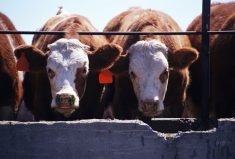Western Canadian feeder cattle prices traded $3 to $7 lower in comparison to week-ago levels as the market continues to digest the weaker fed market and softer wholesale beef values. Feedlot operators were more cautious, realizing the current prices don’t pencil profitably, while the deferred live cattle futures dropped like a power window.
Financial risk is definitely higher this year, with growing beef production and sharp increases in pork and poultry supplies. Market chatter this week appeared to notice the outside world and these feeder cattle will eventually end up on plate of a budget-constrained consumer, complaining about food inflation.
Read Also

U.S. grains: Soy futures slide on China demand doubts
Soybean futures posted their first weekly loss in eight weeks at Friday’s close. Corn and wheat futures were also lower.
The deteriorating Canadian dollar had little effect on feeder prices. U.S. feedlot margins are in a devastating position which resulted in limited orders from south of the border. Therefore, Alberta feedlots set the price structure across the Prairies. Certain operations were noticeably absent this week, anticipating better quality and lower prices later in fall. Until feedlots see some change in the overall market environment, there is no need to be anxious this early in the season.
Heavier yearlings once again led the market lower, trading down $3-$7 from last week. However, cattle in the range of 750 to 850 lbs. were steady to marginally weaker; mixed steers in central Alberta weighing 830 lbs. sold for $267 while 870-lb. mixed heifers traded at $241 at the same sale. Feature groups of feeders with efficient feeding potential held value with week-ago levels, but this was rare. Feeder markets were down $4 to as much as $10 late in the week as the futures market eroded.
Calf prices were quite variable across Western Canada but were mostly $4-$8 lower from last week. Alberta has less forage and silage available compared to past years; therefore, larger feedlot operations outside the irrigation regions appear to be shying away on calves. Backgrounding operaters are in the final stages of the grain harvest, so these buyers were also absent. Finally, calves have significant risk because there are ideas yearlings will be $15-$20 cheaper next spring, given the sharp year-over-year increase in second-quarter beef production.
— Jerry Klassen is manager of the Canadian office for Swiss-based grain trader GAP SA Grains and Produits. He is also president and founder of Resilient Capital, which specializes in proprietary commodity futures trading and commodity market analysis. Jerry owns farmland in Manitoba and Saskatchewan but grew up on a mixed farm/feedlot operation in southern Alberta, which keeps him close to the grassroots level of grain and cattle production. Jerry is a graduate of the University of Alberta. He can be reached at 204-504-8339.
















